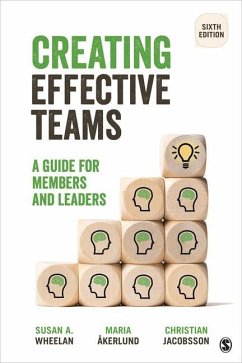Susan A. Wheelan, Maria Åkerlund, Christian Jacobsson
Creating Effective Teams
A Guide for Members and Leaders
Susan A. Wheelan, Maria Åkerlund, Christian Jacobsson
Creating Effective Teams
A Guide for Members and Leaders
- Broschiertes Buch
- Merkliste
- Auf die Merkliste
- Bewerten Bewerten
- Teilen
- Produkt teilen
- Produkterinnerung
- Produkterinnerung
A practical guide for building and sustaining top-performing teams Based on the authors' many years of consulting experience with teams in the public and private sectors, Creating Effective Teams: A Guide for Members and Leaders describes why teams are important, how they function, and what makes them successful. The texts covers the four stages of team development —forming, storming, norming, and performing— to help readers effectively navigate these different phases. Separate chapters are devoted to the responsibilities of team leaders and team members. Susan A. Wheelan, Maria Akerlund, and…mehr
Andere Kunden interessierten sich auch für
![Mitchell Levy on Creating Thought Leaders (2nd Edition) Mitchell Levy on Creating Thought Leaders (2nd Edition)]() Mitchell LevyMitchell Levy on Creating Thought Leaders (2nd Edition)27,99 €
Mitchell LevyMitchell Levy on Creating Thought Leaders (2nd Edition)27,99 €![Creating a Will to Work Creating a Will to Work]() Michael J. EnglerCreating a Will to Work17,99 €
Michael J. EnglerCreating a Will to Work17,99 €![Creating Effective Sales and Marketing Relationships Creating Effective Sales and Marketing Relationships]() Kenneth Le Meunier-FitzhughCreating Effective Sales and Marketing Relationships18,99 €
Kenneth Le Meunier-FitzhughCreating Effective Sales and Marketing Relationships18,99 €![Creating an EVEN Greater Whole Creating an EVEN Greater Whole]() Susan G. SchwartzCreating an EVEN Greater Whole123,99 €
Susan G. SchwartzCreating an EVEN Greater Whole123,99 €![Growing New Ventures, Creating New Jobs Growing New Ventures, Creating New Jobs]() Jana MatthewsGrowing New Ventures, Creating New Jobs78,99 €
Jana MatthewsGrowing New Ventures, Creating New Jobs78,99 €![Creating Your Limitless Life Creating Your Limitless Life]() Esther ZeledonCreating Your Limitless Life14,99 €
Esther ZeledonCreating Your Limitless Life14,99 €![Creating your business of distinction Creating your business of distinction]() April JasperCreating your business of distinction17,99 €
April JasperCreating your business of distinction17,99 €-
-
-
A practical guide for building and sustaining top-performing teams Based on the authors' many years of consulting experience with teams in the public and private sectors, Creating Effective Teams: A Guide for Members and Leaders describes why teams are important, how they function, and what makes them successful. The texts covers the four stages of team development —forming, storming, norming, and performing— to help readers effectively navigate these different phases. Separate chapters are devoted to the responsibilities of team leaders and team members. Susan A. Wheelan, Maria Akerlund, and Christian Jacobsson highlight common problems that occur frequently in groups as well as provide practical tips, real-life examples, and questionnaires to help address those problems. The Sixth Edition includes a new Chapter 11 on Changes in Team Functioning explores the benefits and challenges of working on fluid teams, self-managed teams, agile teams, virtual teams, and multicultural teams. A significantly revised Chapter 12 highlights the latest research on the integrated model of group development.
Produktdetails
- Produktdetails
- Verlag: Sage Publications, Inc
- 6. Auflage
- Seitenzahl: 168
- Erscheinungstermin: 26. August 2020
- Englisch
- Abmessung: 229mm x 152mm x 10mm
- Gewicht: 254g
- ISBN-13: 9781544332970
- ISBN-10: 1544332971
- Artikelnr.: 59640188
- Herstellerkennzeichnung
- Libri GmbH
- Europaallee 1
- 36244 Bad Hersfeld
- gpsr@libri.de
- Verlag: Sage Publications, Inc
- 6. Auflage
- Seitenzahl: 168
- Erscheinungstermin: 26. August 2020
- Englisch
- Abmessung: 229mm x 152mm x 10mm
- Gewicht: 254g
- ISBN-13: 9781544332970
- ISBN-10: 1544332971
- Artikelnr.: 59640188
- Herstellerkennzeichnung
- Libri GmbH
- Europaallee 1
- 36244 Bad Hersfeld
- gpsr@libri.de
Susan Wheelan was president of GDQ Associates, Inc. Until 2001, she was a professor of psychological studies and faculty director of the Training and Development Center at Temple University. Dr. Wheelan received Temple University's Great Teacher Award in 1992. She also worked as a psychologist in a number of hospital and clinical settings. Dr. Wheelan was the author of Facilitating Training Groups; Group Processes: A Developmental Perspective; Creating Effective Teams: A Guide for Members and Leaders; and Faculty Groups: From Frustration to Collaboration. She was editor of the Handbook of Group Research and Practice and coeditor of The Lewin Legacy: Field Theory in Current Practice and Advances in Field Theory. She wrote 66 research articles for publication.
Preface About the Authors Chapter 1
Why Groups? Groups Have a Long History of Success We Need Groups Every Day Groups Increase Our Knowledge Base When Teams Are Good, They're Very, Very Good Creating Effective Teams How to Use This Book Chapter 2
Effective Organizational Support for Teams Plant Groups in a Favorable Organizational Climate Give Groups What They Need to Do Their Best Pick Members Based on Their Ability to Do the Task and Their Ability to Contribute to Group Success Educate People for Group Participation Competence Avoid Unsubstantiated Team Development and Consultation Strategies Avoid Helping Groups Too Much Make Sure Each Group Has Enough Autonomy to Do Its Work but Remains Connected With the Rest of the Organization Conduct Organizational Support Reviews Regularly The Organizational Support Checklist Chapter 3
From Groups to Teams: The Stages of Group Development Stage 1: Dependence and Inclusion Stage 2: Counterdependence and Fighting Stage 3: Trust and Structure Stage 4: Work and Productivity Surviving Group Development Chapter 4
How Do High Performance Teams Function? The Characteristics of High Performance Teams Ten Keys to Productivity Team Performance Checklist Chapter 5
Effective Team Members Don't Blame Others for Group Problems Encourage the Process of Goal, Role, and Task Clarification Encourage the Adoption of an Open Communication Structure in Which All Member Input and Feedback Are Heard Promote an Appropriate Ratio of Task and Supportive Communications Promote the Use of Effective Problem-Solving and Decision-Making Procedures Encourage the Establishment of Norms That Support Productivity, Innovation, and Freedom of Expression Go Along With Norms That Promote Group Effectiveness and Productivity Promote Group Cohesion and Cooperation Effective Member Checklist Chapter 6
Effective Team Leadership Don't Take On Every Leadership Assignment You Are Offered Adjust Your Leadership Style to Meet the Developmental Needs of the Group at a Particular Time Leadership at Stage 1: Be a Directive and Confident Leader Leadership at Stage 2: When Members Begin to Demand More Participation in Running the Group, Slowly Begin to Empower Them Leadership at Stage 3: Involve Members in the Leadership Function Leadership at Stage 4: Participate as an Expert Member of Your Team Effective Leader Checklist Chapter 7
Navigating Stage 1 Goals of Stage 1 Concerns About Safety and Inclusion Dependence on the Designated Leader A Wish for Order and Structure Chapter 8
Surviving Stage 2 Goals of Stage 2 Create a Unified Group Culture Create a Unified and Effective Group Structure Chapter 9
Reorganizing at Stage 3 Goals of Stage 3 Fine-Tuning Roles, Organization, and Procedures Solidifying Positive Relationships Chapter 10
Sustaining High Performance Goals of Stage 4 Getting the Work Done Well Making Decisions Cohesion and Conflict Maintaining High Performance Chapter 11
Changes in Team Functioning Fluid Teams Self-Managed Teams Agile Teams Virtual Teams Multicultural Teams Chapter 12
Research on the Integrated Model of Group Development Does the Model Describe What Really Happens in Groups? How Are Groups Distributed Across the Four Stages? On Average, How Long Does the Development Process Take? Does Team Building Have Any Effect? Does Group Size Affect Group Maturity? How Do Work Groups in Different Sectors Function? A Final Thought Bibliography Index
Why Groups? Groups Have a Long History of Success We Need Groups Every Day Groups Increase Our Knowledge Base When Teams Are Good, They're Very, Very Good Creating Effective Teams How to Use This Book Chapter 2
Effective Organizational Support for Teams Plant Groups in a Favorable Organizational Climate Give Groups What They Need to Do Their Best Pick Members Based on Their Ability to Do the Task and Their Ability to Contribute to Group Success Educate People for Group Participation Competence Avoid Unsubstantiated Team Development and Consultation Strategies Avoid Helping Groups Too Much Make Sure Each Group Has Enough Autonomy to Do Its Work but Remains Connected With the Rest of the Organization Conduct Organizational Support Reviews Regularly The Organizational Support Checklist Chapter 3
From Groups to Teams: The Stages of Group Development Stage 1: Dependence and Inclusion Stage 2: Counterdependence and Fighting Stage 3: Trust and Structure Stage 4: Work and Productivity Surviving Group Development Chapter 4
How Do High Performance Teams Function? The Characteristics of High Performance Teams Ten Keys to Productivity Team Performance Checklist Chapter 5
Effective Team Members Don't Blame Others for Group Problems Encourage the Process of Goal, Role, and Task Clarification Encourage the Adoption of an Open Communication Structure in Which All Member Input and Feedback Are Heard Promote an Appropriate Ratio of Task and Supportive Communications Promote the Use of Effective Problem-Solving and Decision-Making Procedures Encourage the Establishment of Norms That Support Productivity, Innovation, and Freedom of Expression Go Along With Norms That Promote Group Effectiveness and Productivity Promote Group Cohesion and Cooperation Effective Member Checklist Chapter 6
Effective Team Leadership Don't Take On Every Leadership Assignment You Are Offered Adjust Your Leadership Style to Meet the Developmental Needs of the Group at a Particular Time Leadership at Stage 1: Be a Directive and Confident Leader Leadership at Stage 2: When Members Begin to Demand More Participation in Running the Group, Slowly Begin to Empower Them Leadership at Stage 3: Involve Members in the Leadership Function Leadership at Stage 4: Participate as an Expert Member of Your Team Effective Leader Checklist Chapter 7
Navigating Stage 1 Goals of Stage 1 Concerns About Safety and Inclusion Dependence on the Designated Leader A Wish for Order and Structure Chapter 8
Surviving Stage 2 Goals of Stage 2 Create a Unified Group Culture Create a Unified and Effective Group Structure Chapter 9
Reorganizing at Stage 3 Goals of Stage 3 Fine-Tuning Roles, Organization, and Procedures Solidifying Positive Relationships Chapter 10
Sustaining High Performance Goals of Stage 4 Getting the Work Done Well Making Decisions Cohesion and Conflict Maintaining High Performance Chapter 11
Changes in Team Functioning Fluid Teams Self-Managed Teams Agile Teams Virtual Teams Multicultural Teams Chapter 12
Research on the Integrated Model of Group Development Does the Model Describe What Really Happens in Groups? How Are Groups Distributed Across the Four Stages? On Average, How Long Does the Development Process Take? Does Team Building Have Any Effect? Does Group Size Affect Group Maturity? How Do Work Groups in Different Sectors Function? A Final Thought Bibliography Index
Preface About the Authors Chapter 1
Why Groups? Groups Have a Long History of Success We Need Groups Every Day Groups Increase Our Knowledge Base When Teams Are Good, They're Very, Very Good Creating Effective Teams How to Use This Book Chapter 2
Effective Organizational Support for Teams Plant Groups in a Favorable Organizational Climate Give Groups What They Need to Do Their Best Pick Members Based on Their Ability to Do the Task and Their Ability to Contribute to Group Success Educate People for Group Participation Competence Avoid Unsubstantiated Team Development and Consultation Strategies Avoid Helping Groups Too Much Make Sure Each Group Has Enough Autonomy to Do Its Work but Remains Connected With the Rest of the Organization Conduct Organizational Support Reviews Regularly The Organizational Support Checklist Chapter 3
From Groups to Teams: The Stages of Group Development Stage 1: Dependence and Inclusion Stage 2: Counterdependence and Fighting Stage 3: Trust and Structure Stage 4: Work and Productivity Surviving Group Development Chapter 4
How Do High Performance Teams Function? The Characteristics of High Performance Teams Ten Keys to Productivity Team Performance Checklist Chapter 5
Effective Team Members Don't Blame Others for Group Problems Encourage the Process of Goal, Role, and Task Clarification Encourage the Adoption of an Open Communication Structure in Which All Member Input and Feedback Are Heard Promote an Appropriate Ratio of Task and Supportive Communications Promote the Use of Effective Problem-Solving and Decision-Making Procedures Encourage the Establishment of Norms That Support Productivity, Innovation, and Freedom of Expression Go Along With Norms That Promote Group Effectiveness and Productivity Promote Group Cohesion and Cooperation Effective Member Checklist Chapter 6
Effective Team Leadership Don't Take On Every Leadership Assignment You Are Offered Adjust Your Leadership Style to Meet the Developmental Needs of the Group at a Particular Time Leadership at Stage 1: Be a Directive and Confident Leader Leadership at Stage 2: When Members Begin to Demand More Participation in Running the Group, Slowly Begin to Empower Them Leadership at Stage 3: Involve Members in the Leadership Function Leadership at Stage 4: Participate as an Expert Member of Your Team Effective Leader Checklist Chapter 7
Navigating Stage 1 Goals of Stage 1 Concerns About Safety and Inclusion Dependence on the Designated Leader A Wish for Order and Structure Chapter 8
Surviving Stage 2 Goals of Stage 2 Create a Unified Group Culture Create a Unified and Effective Group Structure Chapter 9
Reorganizing at Stage 3 Goals of Stage 3 Fine-Tuning Roles, Organization, and Procedures Solidifying Positive Relationships Chapter 10
Sustaining High Performance Goals of Stage 4 Getting the Work Done Well Making Decisions Cohesion and Conflict Maintaining High Performance Chapter 11
Changes in Team Functioning Fluid Teams Self-Managed Teams Agile Teams Virtual Teams Multicultural Teams Chapter 12
Research on the Integrated Model of Group Development Does the Model Describe What Really Happens in Groups? How Are Groups Distributed Across the Four Stages? On Average, How Long Does the Development Process Take? Does Team Building Have Any Effect? Does Group Size Affect Group Maturity? How Do Work Groups in Different Sectors Function? A Final Thought Bibliography Index
Why Groups? Groups Have a Long History of Success We Need Groups Every Day Groups Increase Our Knowledge Base When Teams Are Good, They're Very, Very Good Creating Effective Teams How to Use This Book Chapter 2
Effective Organizational Support for Teams Plant Groups in a Favorable Organizational Climate Give Groups What They Need to Do Their Best Pick Members Based on Their Ability to Do the Task and Their Ability to Contribute to Group Success Educate People for Group Participation Competence Avoid Unsubstantiated Team Development and Consultation Strategies Avoid Helping Groups Too Much Make Sure Each Group Has Enough Autonomy to Do Its Work but Remains Connected With the Rest of the Organization Conduct Organizational Support Reviews Regularly The Organizational Support Checklist Chapter 3
From Groups to Teams: The Stages of Group Development Stage 1: Dependence and Inclusion Stage 2: Counterdependence and Fighting Stage 3: Trust and Structure Stage 4: Work and Productivity Surviving Group Development Chapter 4
How Do High Performance Teams Function? The Characteristics of High Performance Teams Ten Keys to Productivity Team Performance Checklist Chapter 5
Effective Team Members Don't Blame Others for Group Problems Encourage the Process of Goal, Role, and Task Clarification Encourage the Adoption of an Open Communication Structure in Which All Member Input and Feedback Are Heard Promote an Appropriate Ratio of Task and Supportive Communications Promote the Use of Effective Problem-Solving and Decision-Making Procedures Encourage the Establishment of Norms That Support Productivity, Innovation, and Freedom of Expression Go Along With Norms That Promote Group Effectiveness and Productivity Promote Group Cohesion and Cooperation Effective Member Checklist Chapter 6
Effective Team Leadership Don't Take On Every Leadership Assignment You Are Offered Adjust Your Leadership Style to Meet the Developmental Needs of the Group at a Particular Time Leadership at Stage 1: Be a Directive and Confident Leader Leadership at Stage 2: When Members Begin to Demand More Participation in Running the Group, Slowly Begin to Empower Them Leadership at Stage 3: Involve Members in the Leadership Function Leadership at Stage 4: Participate as an Expert Member of Your Team Effective Leader Checklist Chapter 7
Navigating Stage 1 Goals of Stage 1 Concerns About Safety and Inclusion Dependence on the Designated Leader A Wish for Order and Structure Chapter 8
Surviving Stage 2 Goals of Stage 2 Create a Unified Group Culture Create a Unified and Effective Group Structure Chapter 9
Reorganizing at Stage 3 Goals of Stage 3 Fine-Tuning Roles, Organization, and Procedures Solidifying Positive Relationships Chapter 10
Sustaining High Performance Goals of Stage 4 Getting the Work Done Well Making Decisions Cohesion and Conflict Maintaining High Performance Chapter 11
Changes in Team Functioning Fluid Teams Self-Managed Teams Agile Teams Virtual Teams Multicultural Teams Chapter 12
Research on the Integrated Model of Group Development Does the Model Describe What Really Happens in Groups? How Are Groups Distributed Across the Four Stages? On Average, How Long Does the Development Process Take? Does Team Building Have Any Effect? Does Group Size Affect Group Maturity? How Do Work Groups in Different Sectors Function? A Final Thought Bibliography Index








